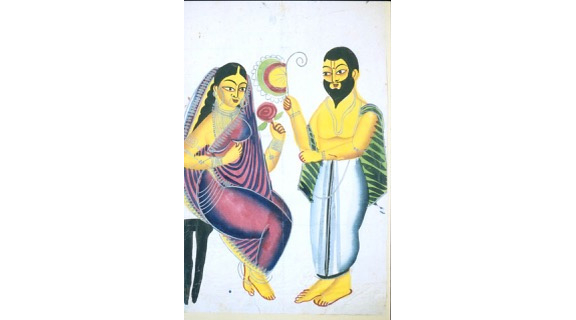Kalighat Paintings: Murder in the Collection

Written by Piali Roy.
A notorious murder case is one of the subjects of the ROM’s collection of mid-nineteenth century Kalighat paintings, an urban folk art style that developed around a popular Kali temple in Kolkata, India.
The Kalighat paintings were the sort of souvenir one could buy after a visit to the temple. The artists had once been itinerant scroll painters who had switched to hand-made paper sheets (instead of cloth) after they moved to the British imperial capital of India, Kolkata, in the 1830s. The “pats” were painted rapidly in bright water colours and by families of artisans. One artist would paint the outlines which would then be coloured in by women artists, each one assigned a different colour. In this way, it is said, 200 to 300 paintings could be completed in one hour.
So it makes sense that many of the seven paintings from the ROM’s collection, donated by Cawthra Mulock in 1996, show straight-foward representations from Hindu iconography such as Krishna with his consort Radha, the elephant god Ganesh, and the goddess Durga killing the demon Mahishasura.


[left] Painting of the goddess Durga kills the demon Mahisasura, Unknown artist, watercolour on paper,
Kalighat, Calcutta, Bengal, India,19th century, ROM 996.117.4 Gift of Cawthra Mulock
[right] Paintig of Radha Krishna, Unknown artist, watercolour on paper, Kalighat, Calcutta, Bengal, India,
19th century, ROM 996.117.3 Gift of Cawthra Mulock

The Mahant (priest) offers Elokeshi a drink, Unknown artist, watercolour on paper,
Kalighat, Kolkata, Bengal, India, 19th century, ROM 996.117.6 Gift of Cawthra Mulock
The Kalighat painters, most of whom are unnamed, straddled the sacred and the profane in other ways too. They used their art for other kinds of social commentary: mocking upper-class Bengali men for their newly adopted British manners; depicting the world of courtesans whose clientale were sometimes shown as lapdogs; and even painting scenes of wives beating their husbands to show the upside down-ness of a changing world.
But it is the “Tarakeswar Affair” paintings that catches one’s attention. They remind us that our obsession with the salacious story, whether it is the latest Trump rumour or a nineteenth-century murder case in Bengal, is nothing new.
